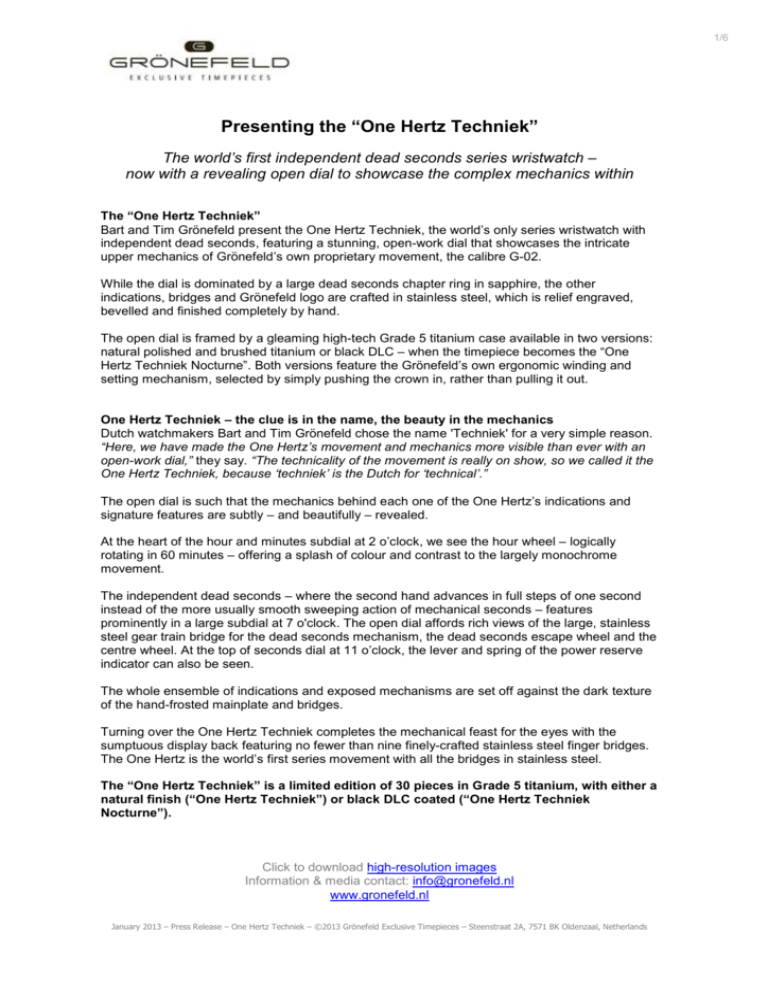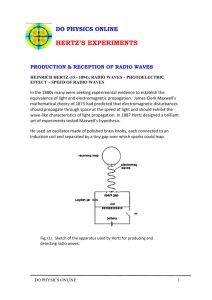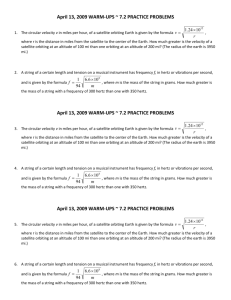1/6 Presenting the “One Hertz Techniek” The world`s first
advertisement

1/6 Presenting the “One Hertz Techniek” The world’s first independent dead seconds series wristwatch – now with a revealing open dial to showcase the complex mechanics within The “One Hertz Techniek” Bart and Tim Grönefeld present the One Hertz Techniek, the world’s only series wristwatch with independent dead seconds, featuring a stunning, open-work dial that showcases the intricate upper mechanics of Grönefeld’s own proprietary movement, the calibre G-02. While the dial is dominated by a large dead seconds chapter ring in sapphire, the other indications, bridges and Grönefeld logo are crafted in stainless steel, which is relief engraved, bevelled and finished completely by hand. The open dial is framed by a gleaming high-tech Grade 5 titanium case available in two versions: natural polished and brushed titanium or black DLC – when the timepiece becomes the “One Hertz Techniek Nocturne”. Both versions feature the Grönefeld’s own ergonomic winding and setting mechanism, selected by simply pushing the crown in, rather than pulling it out. One Hertz Techniek – the clue is in the name, the beauty in the mechanics Dutch watchmakers Bart and Tim Grönefeld chose the name 'Techniek' for a very simple reason. “Here, we have made the One Hertz’s movement and mechanics more visible than ever with an open-work dial,” they say. “The technicality of the movement is really on show, so we called it the One Hertz Techniek, because ‘techniek’ is the Dutch for ‘technical’.” The open dial is such that the mechanics behind each one of the One Hertz’s indications and signature features are subtly – and beautifully – revealed. At the heart of the hour and minutes subdial at 2 o’clock, we see the hour wheel – logically rotating in 60 minutes – offering a splash of colour and contrast to the largely monochrome movement. The independent dead seconds – where the second hand advances in full steps of one second instead of the more usually smooth sweeping action of mechanical seconds – features prominently in a large subdial at 7 o'clock. The open dial affords rich views of the large, stainless steel gear train bridge for the dead seconds mechanism, the dead seconds escape wheel and the centre wheel. At the top of seconds dial at 11 o’clock, the lever and spring of the power reserve indicator can also be seen. The whole ensemble of indications and exposed mechanisms are set off against the dark texture of the hand-frosted mainplate and bridges. Turning over the One Hertz Techniek completes the mechanical feast for the eyes with the sumptuous display back featuring no fewer than nine finely-crafted stainless steel finger bridges. The One Hertz is the world’s first series movement with all the bridges in stainless steel. The “One Hertz Techniek” is a limited edition of 30 pieces in Grade 5 titanium, with either a natural finish (“One Hertz Techniek”) or black DLC coated (“One Hertz Techniek Nocturne”). Click to download high-resolution images Information & media contact: info@gronefeld.nl www.gronefeld.nl January 2013 – Press Release – One Hertz Techniek – ©2013 Grönefeld Exclusive Timepieces – Steenstraat 2A, 7571 BK Oldenzaal, Netherlands 2/6 Winding-Setting mechanism and hacked seconds With the One Hertz, winding and setting are selected by pushing the crown in, instead of pulling it out – a very ergonomic system. The winding-setting (W S) indicator at 3 o’clock provides a neat visual signal as to the mode selected, and the winding-setting lever and its spring are visible around the indicator thanks to the open dial. What’s more, the counter-poised seconds hand can be ‘hacked’ – i.e. stopped – when ‘setting’ is selected, to ensure maximum precision when adjusting the time. The “One Hertz Techniek” and the “One Hertz Techniek Nocturne” While the One Hertz Techniek is available in polished and brushed natural Grade 5 titanium, Bart and Tim Grönefeld have harnessed the talents of Finnish company DIARC, world-renowned for their coating techniques, to offer a striking black DLC coated version as well. Bart and Tim have dubbed this black version the “One Hertz Techniek Nocturne” after ‘nocturne’, the style of painting that depicts scenes evoking night. Dead seconds The dead seconds complication was a very respected mechanical complication until the 1980s because it denoted superlative accuracy. It was traditionally derived from other mechanisms such as a constant force device or remontoir d’égalité. However, the popularity of dead seconds faded with the dominance of quartz movements, which also stepped in full seconds. A smooth sweeping second hand came to differentiate mechanical from quartz. But with the One Hertz and its unique secondary gear train, Bart and Tim Grönefeld have resurrected this long-neglected complication and re-positioned it where the complication originated – on the pedestal of high precision. The stepping movement of the large second hand of the One Hertz subtly signals its unique mechanism, imperceptible to most, but obvious to haute horlogerie connoisseurs, who will appreciate the sublime, flawless fine-finishing of all 285 components of the calibre G-02 movement. January 2013 – Press Release – One Hertz Techniek – ©2013 Grönefeld Exclusive Timepieces – Steenstraat 2A, 7571 BK Oldenzaal, Netherlands 3/6 History of Dead Seconds With the introduction of the pendulum in the 17th century, clocks finally became accurate enough to measure seconds. It was not long before a hand indicating seconds on a long clock’s dial signified a precision timepiece. A pendulum with a period – the time to swing forward and back – of two seconds (the most common) resulted in a single tick per second. The invention of the balance spring, which replaced the pendulum, enabled miniaturisation. As portable pocket watches became more accurate, watchmakers naturally thought to copy the onesecond steps of the seconds hand which signified a precision timepiece. However, the rapidly oscillating balance meant that it could not be directly driven as with the pendulum, so it required either a new mechanism if independent, or be driven from another complication e.g. constant force device. While pocket watches have featured independent dead seconds in the past, the Grönefeld One Hertz was the first series wristwatch to feature independent dead seconds. The Grönefeld One Hertz is unique among wristwatches in that its dead seconds are powered by a secondary gear train, independent of the gear train for the hour and minute indications. One Hertz The hertz (symbol: Hz) is the SI unit of frequency defined as the number of cycles per second of a periodic phenomenon. This SI unit is named after Heinrich Hertz. One Hertz simply means "one cycle per second". The second (SI symbol: s), sometimes abbreviated sec., is the name of a unit of time, and is the international base unit of time. To highlight the SI seconds, the One Hertz displays dead seconds with a large seconds hand in its own dial. Hours and minutes are non-SI units of time because they do not use the decimal system so are displayed separately. Mechanical wristwatch movements often have balance frequencies of 2.5 to 5 hertz, which results in the seconds hand making tiny steps of 5 to 10 steps each second and looking like a smooth movement. The seconds hand of the One Hertz is either stationary (dead) or jumping in a full one-second increment each second. The “One Hertz” independent dead seconds complication Displaying dead seconds in a wristwatch without a constant force device is no easy task. The friction of the mechanism has to be absolutely minimal so it does not interfere with the escapement. Bart and Tim Grönefeld used an independent dead seconds mechanism that is driven from its own secondary gear train with its own power supply. The seconds are driven from one mainspring barrel and the hours and minutes from another. Friction is with this system guaranteed to an absolute minimum and the complication has no adverse influence on the escapement and free sprung balance. The two mainspring barrels are wound simultaneously from the crown, which features an innovative “push to set”, “push to wind function”, with the mode selected indicated at 3 o’clock. A power reserve indicator at the top of the dead seconds dial keeps track of the 72 hours of autonomy. January 2013 – Press Release – One Hertz Techniek – ©2013 Grönefeld Exclusive Timepieces – Steenstraat 2A, 7571 BK Oldenzaal, Netherlands 4/6 Technical Specifications for the “One Hertz Techniek” The “One Hertz Techniek” is a limited edition of 30 pieces Features and indications Independent dead seconds – large dial at 7 o’clock Hour and minutes – subdial at 2 o’clock Power reserve indicator at 11 o’clock Innovative Winding-Setting mechanism Winding-Setting indicator at 3 o’clock In-house calibre G-02 Case and dial Case material: Grade 5 polished and brushed titanium and black DLC (Diamond Like Carbon) coating Engraving: “Titanium”, “Limited 30 pieces” and the serial number Screws: Stainless steel security screws Case dimensions: 43 mm x 12.5 mm Sapphire crystals: Top domed with antireflective treatment both sides; flat display back with antireflective treatment on both sides Water resistance: 3atm/30m/100 feet Crown: Titanium, black DLC coated with engraved “G” logo and push to set/wind function Dial: Stainless steel open dial. Relief engraved, bevelled and finished by hand Hands: Hours and minutes, large counter-poised seconds, power-reserve and setting-winding Strap and buckle: Hand-sewn matte black, alligator leather with steel tang buckle black DLC coated (Nocturne), Grönefeld logo Movement Calibre G-02: Mechanical hand winding, independent dead seconds, power reserve indicator and setting mechanism indicator. Dimensions: 34mm x 9.5 mm No. of parts: 285 No. of jewels: 39 jewels set in gold chatons Power reserve: 72 hours Barrels: 2 barrels, one for the going gear train and one for the independent dead seconds mechanism. Both barrels are wound at the same speed and in the same direction Balance wheel: 9.12 mm free sprung variable inertia balance wheel Balance frequency: 21’600 bph / 3Hz Balance spring: Phillips terminal overcoil curve, triangle-style stud Escapements: Swiss lever escapement and unique dead seconds escapement January 2013 – Press Release – One Hertz Techniek – ©2013 Grönefeld Exclusive Timepieces – Steenstraat 2A, 7571 BK Oldenzaal, Netherlands 5/6 Main Plate: Hand frosted and spotted black rhodium plated nickel silver Bridges: Stainless steel hand bevelled, micro-blasted, circular grain on the top, relief engraved on micro blasted surface Gearing: 2 independent gear trains each with their own energy sources (2 barrels) Dead seconds mechanism: Independent mechanism, cam with 30 teeth on the going gear train on the fourth wheel, escape wheel on the fourth wheel of the independent gear train, unique double lever with 4 jewelled pallets Winding-Setting mechanism: Push function crown for winding or setting Power reserve mechanism: Classic Breguet style by means of a cone moving up and down on the threaded barrel arbour January 2013 – Press Release – One Hertz Techniek – ©2013 Grönefeld Exclusive Timepieces – Steenstraat 2A, 7571 BK Oldenzaal, Netherlands 6/6 Biography: Bart and Tim Grönefeld The name Grönefeld and the art of watchmaking have a family history spanning a hundred years, originating in the ancient town of Oldenzaal in the Netherlands. There, in a shop facing the ancient basilica church from 1240, Johan Grönefeld, Bart and Tim’s grandfather, began his career as a watchmaker in 1912, marking the beginning of the highly talented dynasty of Grönefeld watchmakers that continues today. Bart and Tim’s workshop is located in Johan Grönefeld’s original building, representing a continuous, unbroken watchmaking family history that is exceptionally rare to find anywhere in the world today. Bart and Tim underwent extensive training in Switzerland, and within a relatively short span of time proved themselves adept world specialists in the production of the most coveted and exquisite horological complications of all: the tourbillon and the minute repeater wristwatch. In 2008, after working anonymously behind the scenes for prestigious Swiss brands, they presented the first watch bearing their own name, the GTM-06 Tourbillon Minute Repeater. In 2010, Bart and Tim presented their second watch, the One Hertz, the world’s first wristwatch with independent dead seconds and featuring a completely new movement, the G-02 Calibre. The One Hertz classic collection has grown to include the One Hertz 1912, One Hertz Dune, One Hertz Ruthenium, One Hertz Titanium and One Hertz Platinum, while the contemporary collection, launched in 2012, includes the One Hertz Fire and the One Hertz Ice. In 2013, the open-dial One Hertz Techniek was launched. The One Hertz is a prize-winning timepiece. It was awarded the Innovation prize in the 0024 WatchWorld Watch of the Year contest in 2011 and was voted Watch of the Year in 2011 by members of the influential watch forum Timezone. January 2013 – Press Release – One Hertz Techniek – ©2013 Grönefeld Exclusive Timepieces – Steenstraat 2A, 7571 BK Oldenzaal, Netherlands







